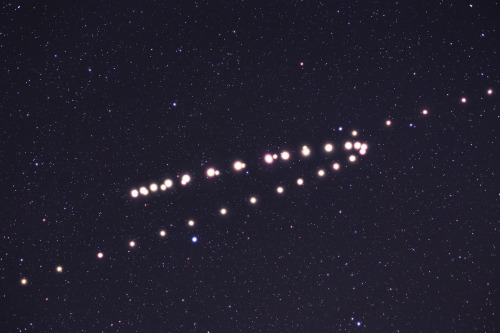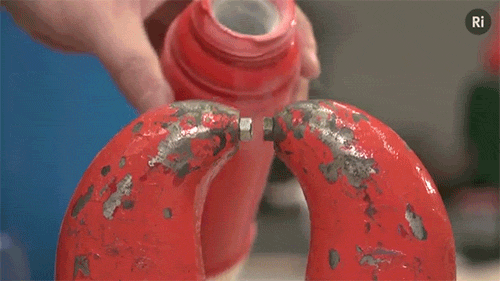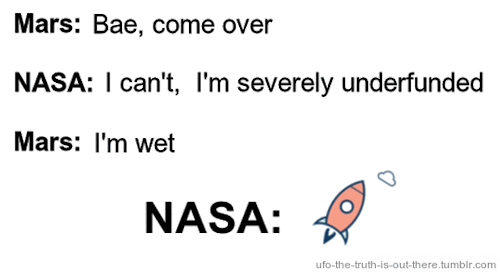Retrograde Motion Of Mars In The Night Sky Of The Earth.

Retrograde motion of Mars in the night sky of the Earth.
Image Credit: Tunc Tezel
More Posts from Riekod and Others
Two Steps Forward in the Search for Life on Mars
We haven’t found aliens but we are a little further along in our search for life on Mars thanks to two recent discoveries from our Curiosity Rover.

We detected organic molecules at the harsh surface of Mars! And what’s important about this is we now have a lot more certainty that there’s organic molecules preserved at the surface of Mars. We didn’t know that before.
One of the discoveries is we found organic molecules just beneath the surface of Mars in 3 billion-year-old sedimentary rocks.

Second, we’ve found seasonal variations in methane levels in the atmosphere over 3 Mars years (nearly 6 Earth years). These two discoveries increase the chances that the record of habitability and potential life has been preserved on the Red Planet despite extremely harsh conditions on the surface.

Both discoveries were made by our chem lab that rides aboard the Curiosity rover on Mars.

Here’s an image from when we installed the SAM lab on the rover. SAM stands for “Sample Analysis at Mars” and SAM did two things on Mars for this discovery.
One - it tested Martian rocks. After the arm selects a sample of pulverized rock, it heats up that sample and sends that gas into the chamber, where the electron stream breaks up the chemicals so they can be analyzed.
What SAM found are fragments of large organic molecules preserved in ancient rocks which we think come from the bottom of an ancient Martian lake. These organic molecules are made up of carbon and hydrogen, and can include other elements like nitrogen and oxygen. That’s a possible indicator of ancient life…although non-biological processes can make organic molecules, too.
The other action SAM did was ‘sniff’ the air.

When it did that, it detected methane in the air. And for the first time, we saw a repeatable pattern of methane in the Martian atmosphere. The methane peaked in the warm, summer months, and then dropped in the cooler, winter months.

On Earth, 90 percent of methane is produced by biology, so we have to consider the possibility that Martian methane could be produced by life under the surface. But it also could be produced by non-biological sources. Right now, we don’t know, so we need to keep studying the Mars!

One of our upcoming Martian missions is the InSight lander. InSight, short for Interior Exploration using Seismic Investigations, Geodesy and Heat Transport, is a Mars lander designed to give the Red Planet its first thorough checkup since it formed 4.5 billion years ago. It is the first outer space robotic explorer to study in-depth the “inner space” of Mars: its crust, mantle, and core.
Finding methane in the atmosphere and ancient carbon preserved on the surface gives scientists confidence that our Mars 2020 rover and ESA’s (European Space Agency’s) ExoMars rover will find even more organics, both on the surface and in the shallow subsurface.
Read the full release on today’s announcement HERE.
Make sure to follow us on Tumblr for your regular dose of space: http://nasa.tumblr.com.

Living near the Rocky Mountains, it’s not unusual to look up and find the sky striped with lines of clouds. Such wave clouds are often formed on the lee side of mountains and other topography. But even in the flattest plains, you can find clouds like these at times. That’s because the internal waves necessary to create the clouds can be generated by weather fronts, too.
Imagine a bit of atmosphere sitting between a low-pressure zone and a high-pressure zone. This will be an area of convergence, where winds flow inward and squeeze the fluid parcel in one direction before turning 90 degrees and stretching it in the perpendicular direction. The result is a sharpening of any temperature gradient along the interface. This is the weather front that moves in and causes massive and sudden shifts in temperature.
On one side of the front, warm air rises. Then, as it loses heat and cools, it sinks down the cold side of the front. The sharper the temperature differences become, the stronger this circulation gets. If the air is vertically displaced quickly enough, it will spontaneously generate waves in the atmosphere. With the right moisture conditions, those waves create visible clouds at their crests, as seen here. For more on the process, check out this article over at Physics Today. (Image credit: W. Velasquez; via Physics Today)
It’s sad how much of what is taught in school is useless to over 99% of the population.
There are literally math concepts taught in high school and middle school that are only used in extremely specialized fields or that are even so outdated they aren’t used anymore!


Liquid oxygen is magnetic
Liquid oxygen sticks between the poles of a strong magnet until it boils away into its gas state. This is because it has unpaired electrons, which make each oxygen molecule a tiny magnet with a dipole. Normally, when oxygen is in a flask or in the air, these microscopic magnets point in all directions, cancelling out and meaning that there’s no net magnetic field. When it pours over the permanent magnet, the magnetic molecules all slightly align, creating an induced magnetic field, which reacts with the permanent magnet, making the oxygen stick to the poles. This is called paramagnetism. Click here to watch the video.

Drops that impact a very hot surface will surf on their own vapor, and ones that hit a very cold surface will freeze almost immediately. But what happens when the temperature differences aren’t so extreme? Scientists explored this (above) by dropping room-temperature water droplets onto a cool surface – one warmer than the freezing point but cooler than the dew point at which water condenses.
They found that impacting drops formed a triple halo of condensate (right). The first and brightest ring forms at the radius of the drop’s maximum extent during impact. The second band forms from water vapor that leaves the droplet at impact. As that vapor cools, it condenses into a second band. The final, dimmest band forms as the droplet stabilizes and cools. It’s the result of water vapor near the droplet continuing to cool and condense. (Image and research credit: Y. Zhao et al.; via Nature News; submitted by Kam-Yung Soh)

this morning NASA abandoned their mars rover Opportunity (aka Oppy) because it (she) got hit by a storm on Mars and it knocked her camera and wheels out and her last words to the team were “my battery is low and it is getting cold”. I know she’s a machine but I’m devastated. Oppy is the one who discovered water on Mars. RIP oppy ily space baby

Pale Blue Dot
Look again at that dot. That’s here. That’s home. That’s us. On it everyone you love, everyone you know, everyone you ever heard of, every human being who ever was, lived out their lives. The aggregate of our joy and suffering, thousands of confident religions, ideologies, and economic doctrines, every hunter and forager, every hero and coward, every creator and destroyer of civilization, every king and peasant, every young couple in love, every mother and father, hopeful child, inventor and explorer, every teacher of morals, every corrupt politician, every “superstar,” every “supreme leader,” every saint and sinner in the history of our species lived there–on a mote of dust suspended in a sunbeam.
The Earth is a very small stage in a vast cosmic arena. Think of the rivers of blood spilled by all those generals and emperors so that, in glory and triumph, they could become the momentary masters of a fraction of a dot. Think of the endless cruelties visited by the inhabitants of one corner of this pixel on the scarcely distinguishable inhabitants of some other corner, how frequent their misunderstandings, how eager they are to kill one another, how fervent their hatreds.
Our posturings, our imagined self-importance, the delusion that we have some privileged position in the Universe, are challenged by this point of pale light. Our planet is a lonely speck in the great enveloping cosmic dark. In our obscurity, in all this vastness, there is no hint that help will come from elsewhere to save us from ourselves.
The Earth is the only world known so far to harbor life. There is nowhere else, at least in the near future, to which our species could migrate. Visit, yes. Settle, not yet. Like it or not, for the moment the Earth is where we make our stand.
It has been said that astronomy is a humbling and character-building experience. There is perhaps no better demonstration of the folly of human conceits than this distant image of our tiny world. To me, it underscores our responsibility to deal more kindly with one another, and to preserve and cherish the pale blue dot, the only home we’ve ever known.
– Carl Sagan

The triple point of water
In “Float” artist Susi Sie uses water and oil to create a whimsical landscape of bubbles and droplets. Coalescence is a major player in the action, though Sie uses some clever time manipulations to make her bubbles and droplets multiply as well. Watching coalescence in reverse feels like seeing mitosis happen before your eyes. (Video and image credit: S. Sie)



-
 2boldlyqueer liked this · 3 weeks ago
2boldlyqueer liked this · 3 weeks ago -
 smartdumbassthings liked this · 3 weeks ago
smartdumbassthings liked this · 3 weeks ago -
 blissthisway reblogged this · 3 weeks ago
blissthisway reblogged this · 3 weeks ago -
 nervousperfectionandroid reblogged this · 3 weeks ago
nervousperfectionandroid reblogged this · 3 weeks ago -
 nervousperfectionandroid liked this · 3 weeks ago
nervousperfectionandroid liked this · 3 weeks ago -
 honehbee42 liked this · 3 weeks ago
honehbee42 liked this · 3 weeks ago -
 tachvintlogic reblogged this · 3 weeks ago
tachvintlogic reblogged this · 3 weeks ago -
 oneironism reblogged this · 3 weeks ago
oneironism reblogged this · 3 weeks ago -
 andreamelissamorales reblogged this · 4 weeks ago
andreamelissamorales reblogged this · 4 weeks ago -
 drahgonfly reblogged this · 4 weeks ago
drahgonfly reblogged this · 4 weeks ago -
 cerulaean reblogged this · 1 month ago
cerulaean reblogged this · 1 month ago -
 openyourhead reblogged this · 1 month ago
openyourhead reblogged this · 1 month ago -
 drahgonfly reblogged this · 1 month ago
drahgonfly reblogged this · 1 month ago -
 stardustsprinklebaby reblogged this · 1 month ago
stardustsprinklebaby reblogged this · 1 month ago -
 thecureforinsomnia reblogged this · 1 month ago
thecureforinsomnia reblogged this · 1 month ago -
 caatarssiss reblogged this · 1 month ago
caatarssiss reblogged this · 1 month ago -
 monsterousroyalty reblogged this · 1 month ago
monsterousroyalty reblogged this · 1 month ago -
 monsterousroyalty liked this · 1 month ago
monsterousroyalty liked this · 1 month ago -
 hadez-supreme reblogged this · 1 month ago
hadez-supreme reblogged this · 1 month ago -
 eviltiddyprodnz liked this · 1 month ago
eviltiddyprodnz liked this · 1 month ago -
 aloocha reblogged this · 1 month ago
aloocha reblogged this · 1 month ago -
 mindonvenus reblogged this · 1 month ago
mindonvenus reblogged this · 1 month ago -
 mindonvenus liked this · 1 month ago
mindonvenus liked this · 1 month ago -
 upsidedwnumbrella liked this · 1 month ago
upsidedwnumbrella liked this · 1 month ago -
 slumsaintt reblogged this · 1 month ago
slumsaintt reblogged this · 1 month ago -
 freeyourselfopenyourmind reblogged this · 1 month ago
freeyourselfopenyourmind reblogged this · 1 month ago -
 brunobrza reblogged this · 1 month ago
brunobrza reblogged this · 1 month ago -
 brunobrza liked this · 1 month ago
brunobrza liked this · 1 month ago -
 timeoverload reblogged this · 1 month ago
timeoverload reblogged this · 1 month ago -
 hamradiocas reblogged this · 1 month ago
hamradiocas reblogged this · 1 month ago -
 violetv302 liked this · 1 month ago
violetv302 liked this · 1 month ago -
 ddeerr reblogged this · 1 month ago
ddeerr reblogged this · 1 month ago -
 ddeerr liked this · 1 month ago
ddeerr liked this · 1 month ago -
 riverswater reblogged this · 1 month ago
riverswater reblogged this · 1 month ago -
 mortuusflores reblogged this · 1 month ago
mortuusflores reblogged this · 1 month ago -
 champagnecola liked this · 1 month ago
champagnecola liked this · 1 month ago -
 ui-alcoholic liked this · 1 month ago
ui-alcoholic liked this · 1 month ago -
 flackaszn reblogged this · 1 month ago
flackaszn reblogged this · 1 month ago -
 retalhoserelapsos reblogged this · 1 month ago
retalhoserelapsos reblogged this · 1 month ago -
 kawiza reblogged this · 1 month ago
kawiza reblogged this · 1 month ago -
 luargentum reblogged this · 1 month ago
luargentum reblogged this · 1 month ago -
 non-catalogabile liked this · 1 month ago
non-catalogabile liked this · 1 month ago -
 canterai liked this · 1 month ago
canterai liked this · 1 month ago -
 kittyconcubine reblogged this · 1 month ago
kittyconcubine reblogged this · 1 month ago -
 mushroom--soup liked this · 1 month ago
mushroom--soup liked this · 1 month ago -
 fiumesecco liked this · 1 month ago
fiumesecco liked this · 1 month ago -
 coltellini reblogged this · 1 month ago
coltellini reblogged this · 1 month ago -
 bluejaykay liked this · 1 month ago
bluejaykay liked this · 1 month ago